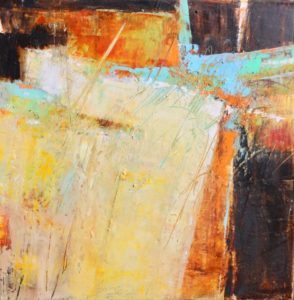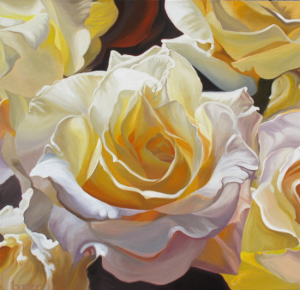Dear Artist,
One of the fun things about Blackberry co-dependency is the ability to send and receive emails pretty well anywhere. Up here in the Rocky Mountains, however, the little darling is as mute as a dead gopher. Missing those soft vibrations of the pocket, I sent my unit with a day-tripping friend who was off the mountain overnight. The machine came back fully revived, her tiny cheeks bulging with fresh seeds.
Ed Abela of Markham, Ontario, asked, “Do you ever have the inclination to make pen and ink sketches on your travels? I find it a useful tool. A few felt pens in different sizes and a small sketchbook can reap rewards. The drawings can be developed into paintings once I’m back in my studio, but can also be left as stand-alone vignettes.”
Thanks, Ed. No, I don’t, not these days, and I’ll tell you why. While I’ve no complaints with pen or pencil sketches, I prefer to cut directly to the chase. I suppose it’s somewhat a commercial decision — my effort goes directly to an eventually more collectable item — but there are artistic considerations as well.
When they make a drawing, many painters find that while they may gain a deeper understanding of the subject, they also lose some of the impetus for more ambitious work. I find worthwhile subjects need to be caught and held in a final, definitive form during the initial wave of connectivity that takes place during that “wow” moment.
Further, the convention of line is much different from the convention of the painterly brush. One tends to be thin and delineatory, the other a juxtaposition of patches. Too much early attention to line can baffle the discovery of an effective pattern. Drawing can run interference on composition.
Also, you may have noted that many seasoned painters simply don’t draw, perhaps because they’ve done so much of it that lines and forms are more or less projected where needed.
Looking back, I’ve been through all kinds of drawing phases. There’s nothing like a beautifully rendered drawing. Many of the not-too-bad ones I did thirty years ago are still in dealer’s drawers. Maybe someday I’ll get them all back and put them into a book. Maybe that’s a good place for them.
Best regards,
Robert
PS: “Drawing is not the same as form.” (Edgar Degas)
Esoterica: It may come as some satisfaction to readers that most everybody disagrees with me. “Drawing is the basis of art,” said Arshile Gorky. “A bad painter cannot draw. But one who draws well can always paint.” And Robert Henri notes, “The sketch hunter moves through life as he finds it, not passing negligently the things he loves, but stopping to know them, and to note them down in the shorthand of his sketchbook.” Also, Jean-Auguste-Dominique Ingres: “Drawing contains everything except the hue.” And Sir William Orpen: “A painting well drawn is always well enough painted.” But then, none of those guys were in love with Blackberries.
This letter was originally published as “Sketches on location” on August 4, 2009.
 The Letters: Vol. 1 and 2, narrated by Dave Genn, are available for download on Amazon, here. Proceeds of sales contribute to the production of The Painter’s Keys.
The Letters: Vol. 1 and 2, narrated by Dave Genn, are available for download on Amazon, here. Proceeds of sales contribute to the production of The Painter’s Keys.
“A critic at my house sees some paintings. Greatly perturbed, he asks for my drawings. My drawings! Never! They are my letters, my secrets.” (Paul Gauguin)
Featured Workshop
The use of cold wax merging with collage material reveals a rich surface filled with depth. Learning when and how to add your personal marks enhances the painting while telling a story.
Held at Gwen Fox’s private Art Sanctuary in Taos, New Mexico. Her 100-year-old adobe home is the perfect environment to inspire and renew your creativity.
There will be private critiques that empower, glorious breakthroughs while basking in a safe environment in which to grow as an artist.
This workshop will fill fast. Limited to 10 artists. Each artist will have their own table.
Featured Artist
Gardens are my enduring inspiration, and getting to the heart of the flower, my passion.









17 Comments
I’m a painter that agrees with Robert. I never enjoyed drawing, tho I’m not half-bad at it… I just always wanted to be a painter. I do all the drawing I need with brushes and for fine work, the back end of the brush serves me well as a tool for sgrafitto, — it’s as close to drawing as I like to get. This note from Robert lightened my day, to hear he wasn’t a drawer either; that, in fact, his drawings lay in some dealer’s “drawer.” Hmm…. what does language tell us here? It’s not that I don’t enjoy viewing drawings, I especially like Matisse’s simple line drawings of the figure for the beauty of the flowing lines, I just prefer to make them with paint. No judgment here, just awareness of what feels right for me.
I agree as well! Each of us as artists bring a boatload of talent in our own distinctive ways, for me moving paint around is my go-to. Sketching is enjoyable and it’s more portable than my acrylics and canvases, but nothing quite like the feeling of squishing out paint.
I have to partially agree with Robert. I tend to do a lot of sketches/ drawings ( ink and coloured pencil) in various sketchbooks that are often with me when I am confronted with the “wow” moment. The problem is ,that when I go back to the studio and try to revisit a sketch as painting , the spontaneity is often lost. The painting becomes laborious ,and I end up liking the sketch better! That said , would I draw or paint something after , had I not actually executed my spontaneous impression ?… and I look at the act of drawing as a practise , similar to that of a pianist who may be working out a musical phrase.
Well said Mary! I never learnt drawing, but I think it has its place. If I don’t sketch what I’m going to paint, it’s like walking into a dark unfamiliar room. That said, when I try to paint from location sketches, the spontaneity and thrill has waned. And I sometimes feel cuckold as if I’m being squeezed into a corner.
Several years ago we had the opportunity to travel around Scotland and Ireland. I travelled with a specially designed sketchbook, pencils and pens. I likely would not turn the sketches I made into paintings, but they have provided wonderful reference notes, and when I look at them now, I am standing there again, in front of an ancient castle feeling the breeze and hearing bird song. These are the best souvenirs I have ever collected.
I agree! I love what a pencil can do on a toothy paper…and the results of a good pen on slick paper. My travel journals with quickly executed sketches take me there as no photograph can! Sometimes I hit them with a bit of watercolor. Many are bare bones drawings. I love that line!
Oh I am very much inclined to do what I call quick plein air painting sketches or small painting studies rather than drawing as preparation for a larger work. Sometimes, I just go straight to a collection 15- 50 photography sketches and dive right in. I find the pencil or even a charcoal sketch a different beast and extremely limited as a tool for capturing the subtle effects of light and interplay of colour that is my deepest passion and which the natural landscape seems to serve up in abundance. Great post!
Almost all my paintings originate from pastel drawings. There’s something about pastels which makes a good transition into paint. Even a quick sketch can work if I go straight to the studio but often its the combination of a rather abstract rendition in pastels and an acute memory of that Wow moment that really work together.
Why draw, when you can paint?
I agree totally! Although I do go to a sketch lab occasionally to home observation skills. You put into words what was I. My heart about the WOW moment which is the whole reason for art I the first place for me. Best expressed with the care of my watercolor brush.
I love the act of painting outdoors just for itself. There is nothing in life more satisfying for me that sitting in front of natural splendour working things out with pencil and pen. However, I only rarely paint larger paintings from these sketches. I paste them in a book with comments, poetry etc and enjoy leafing through said book on occasion to recall my travels.
It’s like comparing apples to oranges. Paintings are just too yummy. Drawing is a good discipline, while painting is pure joy! (And painting apples is much more fun than drawing one in black and white). There’s a certain throwing caution to the wind, a carefree recklessness, to painting that just can’t happen with a pencil! But you must begin by becoming a good draftsman.
Drawing is the foundation for my watercolors. I like to paint from nature and need to get the shape and form in to guide my brush. If I wish to move out of the lines of my sketch to enhance my painting, I will. I have had watercolor students sent to me to teach them to draw. After they finished my class and went back to the watercolor class, they were pleasantly surprise at how much better they painted. I encourage all my students to learn to draw. It helps them to develop their observation of the subject and they have more confidence when they begin to paint because their drawings have broken that white blank surface and gives them direction.
Esoterica says it all for me…..
I draw on the board or canvas, in charcoal, pencil, or in thin ochre or sienna. Then the painting goes into 2nd and 3rd gear. So drawing is first. As for sketchbooks, I use old drawings for the composition and values that get me into 1st gear on a fresh piece.
Plein air brings the light, the shadow. Drawing the form. Who is to say what comes first? God probably did it all at once! We must choose. I don’t think He cares so much what we do first.
I draw or paint, but don’t usually draw and paint. I enjoy both, but keep them separate. I’m not really sure why, but they seem totally different to me.